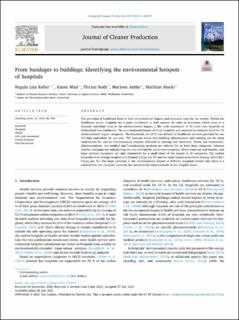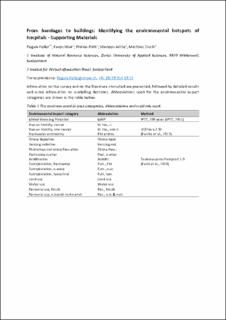Please use this identifier to cite or link to this item:
https://doi.org/10.21256/zhaw-23058| Publication type: | Article in scientific journal |
| Type of review: | Peer review (publication) |
| Title: | From bandages to buildings : identifying the environmental hotspots of hospitals |
| Authors: | Keller, Regula Muir, Karen Roth, Florian Jattke, Marleen Stucki, Matthias |
| et. al: | No |
| DOI: | 10.1016/j.jclepro.2021.128479 10.21256/zhaw-23058 |
| Published in: | Journal of Cleaner Production |
| Volume(Issue): | 319 |
| Issue: | 128479 |
| Issue Date: | 2021 |
| Publisher / Ed. Institution: | Elsevier |
| ISSN: | 0959-6526 |
| Language: | English |
| Subjects: | Hospitals; Health; Carbon footprint; Pharmaceuticals; Life cycle assessment |
| Subject (DDC): | 338.927: Environmental economics and sustainable development 362.11: Hospitals and related institutions |
| Abstract: | The provision of healthcare leads to high environmental impacts and economic costs for our society. Within the healthcare sector, hospitals are a main contributor to both aspects. In order to determine which areas of a hospital contribute most to the environmental impact, a life cycle assessment of 33 acute care hospitals in Switzerland was conducted. The environmental impact of these hospitals was analysed at midpoint level for 16 environmental impact categories. The functional unit (FU) was defined as healthcare services provided by one full-time equivalent for one year. The analysis shows that building infrastructure and catering are the main contributors for various environmental impacts, followed by heating and electricity. Waste and wastewater, pharmaceuticals, and medical and housekeeping products are relevant for at least three categories, whereas textiles, and paper use and printing are only relevant for one to two categories. Direct water use and laundry, and large medical equipment are only responsible for a small share of the impact in all categories. The carbon footprint of an average hospital is 3.2 tonnes CO2eq per FU and the main impact stems from heating with 0.82 t CO2eq per FU. The large variation in the environmental impact of different hospitals reveals that there is a considerable yet untapped potential for sustainability improvements in the hospital sector. |
| URI: | https://digitalcollection.zhaw.ch/handle/11475/23058 |
| Fulltext version: | Published version |
| License (according to publishing contract): | CC BY 4.0: Attribution 4.0 International |
| Departement: | Life Sciences and Facility Management |
| Organisational Unit: | Institute of Natural Resource Sciences (IUNR) |
| Published as part of the ZHAW project: | Green Hospital |
| Appears in collections: | Publikationen Life Sciences und Facility Management |
Files in This Item:
| File | Description | Size | Format | |
|---|---|---|---|---|
| 2021_Keller-etal_From-bandages-to-buildings.pdf | 2.12 MB | Adobe PDF |  View/Open | |
| 2021_Keller-etal_From-bandages-to-buildings_Supporting-Materials.pdf | 402.6 kB | Adobe PDF |  View/Open |
Show full item record
Keller, R., Muir, K., Roth, F., Jattke, M., & Stucki, M. (2021). From bandages to buildings : identifying the environmental hotspots of hospitals. Journal of Cleaner Production, 319(128479). https://doi.org/10.1016/j.jclepro.2021.128479
Keller, R. et al. (2021) ‘From bandages to buildings : identifying the environmental hotspots of hospitals’, Journal of Cleaner Production, 319(128479). Available at: https://doi.org/10.1016/j.jclepro.2021.128479.
R. Keller, K. Muir, F. Roth, M. Jattke, and M. Stucki, “From bandages to buildings : identifying the environmental hotspots of hospitals,” Journal of Cleaner Production, vol. 319, no. 128479, 2021, doi: 10.1016/j.jclepro.2021.128479.
KELLER, Regula, Karen MUIR, Florian ROTH, Marleen JATTKE und Matthias STUCKI, 2021. From bandages to buildings : identifying the environmental hotspots of hospitals. Journal of Cleaner Production. 2021. Bd. 319, Nr. 128479. DOI 10.1016/j.jclepro.2021.128479
Keller, Regula, Karen Muir, Florian Roth, Marleen Jattke, and Matthias Stucki. 2021. “From Bandages to Buildings : Identifying the Environmental Hotspots of Hospitals.” Journal of Cleaner Production 319 (128479). https://doi.org/10.1016/j.jclepro.2021.128479.
Keller, Regula, et al. “From Bandages to Buildings : Identifying the Environmental Hotspots of Hospitals.” Journal of Cleaner Production, vol. 319, no. 128479, 2021, https://doi.org/10.1016/j.jclepro.2021.128479.
Items in DSpace are protected by copyright, with all rights reserved, unless otherwise indicated.